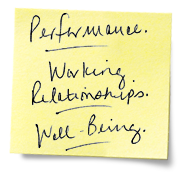Why There Needs To Be an “I” in Team
There is no “I” in team. That common sports slogan often adopted by the business world is clever, memorable — and misleading.
The idea behind the “no I in team” slogan is that teams must focus on what’s best for the team. If team members do that, then the team will be successful. According to the slogan, if team members focus on what’s best for them individually, the team will suffer. The slogan has enough truth in it that it’s easy — and dangerous — to follow.
Smarter teams focus on three pronouns: “it,” “we,” and “I.” Each one refers to a different result that makes your team successful over the long term.
“It” = Performance. “It” refers to getting the job done, achieving team goals. “It” involves making high quality decisions that are innovative, and reducing costs and implementation time. When leaders think about results most think first of performance outcomes.
“We” = Working Relationships. “We” refers to how team members work together to accomplish the team’s work. Smarter teams recognize that “we” as team members need to work together in ways that create trust and commitment and use conflict productively.
“I” = Individual well-being. “I” refers to how I am motivated by my work in the team, whether I get satisfaction from it, and if I’m not too stressed by the work or how the team works together. Team members are more than willing to sacrifice their individual well-being for periods of time to help the team perform. But over time if their individual needs for well-being aren’t met, they can either emotionally check out or act out.
“It,” “We,” and “I” are Linked Together
As your team’s formal leader, it’s critical to pay attention to all three results: performance, working relationships and individual well-being. Your team is a system and ignoring one of these results will, over time, jeopardize the others. If your team performs well but working relationships suffer, members won’t want to work with each other, which will, in turn, lower performance. If team performance and working relationships suffer, team members’ individual well-being is also likely to suffer because a good part of our well-being at work comes from being part of a team that performs well and that is working well together. And if individual well-being suffers, over time team members will check out or act out, and performance and working relationships will suffer.
Good Design Leads to Positive Reinforcement
It’s faulty to assume that if your team is performing well and working well together, team members’ well-being will naturally increase. Whether the three results reinforce each other positively or negatively depends on how the team is designed. A key part of your role as the team’s leader is to help design the team and team members’ roles so what they do, and how they work together to do it, increases rather than decreases their well-being.